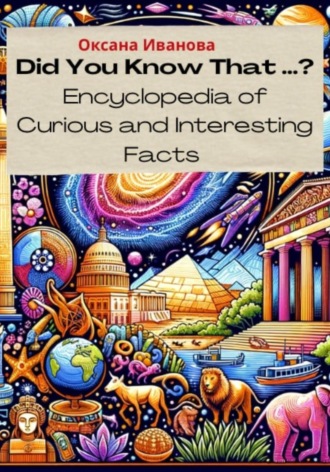
Полная версия
Did You Know That ? Encyclopedia of Curious and Interesting Facts
WORDLIST:
essential – существенный
nutrients – питательные вещества
oxygen – кислород
cells – клетки
remove – удалять
lubricate – смазывать
joints – суставы
tissues – ткани
hydrated – гидратированный
dehydrated – обезвоженный
fatigue – усталость
headache – головная боль
constipation – запор
muscle cramps – мышечные судороги
dizziness – головокружение
confusion – спутанность сознания
seizures – судороги
severe – тяжелый
fatal – смертельный
amount – количество
overall health – общее состояние здоровья
as a general rule of thumb – как общее правило
tips – советы
throughout the day – в течение дня
benefits – преимущества
QUESTIONS:
What percentage of the human body is made up of water?
List four functions of water in the body.
What are some signs of dehydration?
How much water should adults drink per day as a general rule of thumb?
What are three tips for staying hydrated?
Fact 7. Did you know that lightning can travel up to 200 miles in a split second?
Have you ever wondered about the incredible speed of lightning? It can travel up to 200 miles in a split second! This amazing phenomenon is a key part of our planet's weather system.
What is Lightning?
Lightning is a giant electrical discharge that happens inside a thunderstorm cloud or between the cloud and the ground. The air inside the cloud becomes filled with electricity, and when the difference between positive and negative charges gets too big, a lightning bolt is released to balance them out.
Types of Lightning
There are three main types of lightning:
● Intracloud: Happens inside a single thunderstorm cloud.
● Cloud-to-Cloud: Jumps between two different thunderstorm clouds.
● Cloud-to-Ground: The most common type, strikes the earth's surface.
Lightning's Incredible Speed
Lightning travels incredibly fast, usually between 100,000 and 200,000 miles per hour. That means it can cover huge distances in a tiny fraction of a second, making it one of the fastest things in nature.
Safety First
Even though lightning is amazing to watch, it's important to remember that it can also be dangerous. If you're caught in a thunderstorm, the safest thing to do is go inside a sturdy building, stay away from open areas, and unplug electrical appliances.
Interesting Facts
Here are some fun facts about lightning:
● It strikes the Earth about 100 times every second.
● The longest lightning bolt ever recorded was over 267 miles long.
● The tallest building ever hit by lightning is the Burj Khalifa in Dubai.
● Lightning can start wildfires and cause power outages.
● Scientists are still learning about exactly how lightning forms.
Lightning is a powerful and beautiful force of nature. By understanding it and taking safety precautions, we can appreciate its beauty from a distance and stay safe during thunderstorms.
WORDLIST:
lightning – молния
in a split second – в доли секунды
giant – гигантский
discharge – разряд
thunderstorm cloud – грозовая туча
positive and negative charges – положительные и отрицательные заряды
lightning bolt – молния
strikes – ударяет
surface – поверхность
cover huge distances – преодолевать огромные расстояния
tiny fraction – крошечная доля
sturdy – прочный
unplug – отключать
electrical appliances – электроприборы
cause – вызывать
power outages – перебои в подаче электроэнергии
precautions – меры предосторожности
appreciate – ценить
QUESTIONS:
How fast can lightning travel?
What is lightning?
Name the three main types of lightning.
Why is it important to take safety precautions during a thunderstorm?
What is the tallest building ever hit by lightning?
Can lightning cause wildfires and power outages?
Are scientists still learning about lightning formation?
What is the best way to stay safe during a thunderstorm?
Fact 8. Did you know that the human brain can store approximately 2.5 petabytes of data?
That's a lot! It's like having 3 million hours of TV shows or 13 years of video in your head!
How Your Brain Stores Memories
Your brain doesn't store memories in one place. Instead, it spreads them out in different parts of your brain. This helps you remember things quickly and easily.
The hippocampus is a part of your brain that's important for making new memories. It helps you connect new memories to things you already know. The prefrontal cortex helps you organize and find memories. And the amygdala helps you remember things that are emotionally important.
Types of Memory
There are different types of memory:
● Episodic memory: Stores your personal experiences and events.
● Semantic memory: Stores general knowledge and facts.
● Procedural memory: Stores skills and habits.
● Working memory: Holds information you're currently using.
Your Brain Can Change
One amazing thing about your brain is that it can change and adapt throughout your life. This means you can learn new things and remember them, even as you get older.
Things That Affect Your Memory
Some things can affect how well your memory works:
● Age : As you get older, your memory may not be as good as it used to be. But you can still keep your memory sharp by staying active and learning new things.
● Genetics: Some people are born with better memories than others.
● Sleep: Getting enough sleep helps your brain store memories.
● Stress: Too much stress can make it harder to remember things.
● Nutrition : Eating healthy foods can help your brain function better.
Conclusion
Your brain is an amazing organ that can store a lot of information. By understanding how your memory works and taking care of your brain, you can keep your memory sharp for years to come.
WORDLIST:
approximately – приблизительно
store memories – хранить воспоминания
spreads – распространяет
hippocampus – гиппокамп
prefrontal cortex – префронтальная кора
amygdala – миндалевидное тело
general knowledge – общие знания
skills – навыки
habits – привычки
currently – в настоящее время
throughout your life – на протяжении всей жизни
age – возраст
keep your memory sharp – поддерживать остроту памяти
are born – рождаются
nutrition – питание
QUESTIONS:
Approximately how much data can the human brain store?
How does the brain store memories?
Name the main types of memory.
What is the role of the hippocampus in memory formation?
How does the brain's plasticity affect memory?
What are some factors that can affect memory capacity?
How can we optimize our brain health and maximize our memory potential?
Fact 9. Did you know that the average person produces enough saliva to fill an Olympic-sized swimming pool over their lifetime?
That's a lot of spit! But saliva is more than just a wet substance that helps us talk and swallow. It's a vital fluid that plays a crucial role in our oral health, digestive system, and even our immune response.
Saliva's Symphony of Functions
Saliva is not just one thing. It's a complex mixture of water, proteins, enzymes, and minerals that work together to keep our mouths healthy and functioning properly. Here are just a few of saliva's many functions:
● Protects teeth and gums : Saliva contains antimicrobial proteins and enzymes that help to protect our teeth from cavities and gum disease. It also helps to neutralize acids that can damage tooth enamel.
● Aids digestion : Saliva starts the digestive process by breaking down starches into sugars. It also lubricates food, making it easier to swallow.
● Fights infection: Saliva contains antibodies and white blood cells that help to fight off bacteria and viruses that enter our mouths.
● Enhances taste : Saliva helps us to taste food by dissolving chemicals and carrying them to our taste buds.
● Lubricates the mouth: Saliva keeps our mouthsmoist , which reduces friction and makes it easier to speak, chew, and swallow.
The Importance of Saliva Production
Saliva production is essential for maintaining good oral health and overall well-being. When we don't produce enough saliva, we can experience a range of problems, including:
● Tooth decay
● Gum disease
● Oral thrush
● Difficulty chewing, speaking, and swallowing
● Bad breath
Factors Affecting Saliva Production
Several factors can affect saliva production, including:
● Age: Saliva production naturally decreases with age.
● Medications: Some medications, such as antidepressants and decongestants, can have a drying effect on the mouth.
●Medical conditions: Certain diseases, such as diabetes and autoimmune disorders, can also affect saliva production.
● Lifestyle: Smoking, alcohoconsumption, and caffein intake can all reduce saliva flow.
Maintaining Optimal Saliva Production
There are a few things you can do to help maintain optimal saliva production:
● Stay hydrated: Drink plenty of water throughout the day to keep your mouth moist.
● Chew sugar-free gum: Chewing sugar-free gum can help to stimulate saliva production.
● Use a saliva substitute: If you have dry mouth, you can use a saliva substitute or rinse to help keep your mouth moist.
● See your dentist or doctor: If you have persistent dry mouth, see your dentist or doctor to rule out any underlying medical conditions.
Conclusion
Saliva is an essential fluid that plays a vital role in our health. By understanding its functions and how to maintain optimal saliva production, we can help to keep our mouths healthy and our bodies functioning properly.
WORDLIST:
spit – плевать
saliva – слюна
substance – вещество
swallow – глотать
vital fluid – жизненно важная жидкость
crucial role – решающая роль
oral health – здоровье полости рта
digestive system – пищеварительная система
immune response – иммунный ответ
gums – дёсны
cavities – полости
acids – кислоты
aids digestion – помогает пищеварению
starches – крахмалы
lubricates – смазывает
white blood cells – белые кровяные тельца
enhances taste – усиливает вкус
taste buds – вкусовые рецепторы
moist – влажный
reduces friction – уменьшает трение
chew – жевать
for maintaining – для поддержания
overall well-being – общее благополучие
a range of – ряд
tooth decay – кариес зубов
oral thrush – молочница полости рта
bad breath – неприятный запах изо рта
decreases – уменьшается
decongestants – противоотечные средства
consumption – потребление
intake – потребление
persistent – постоянный
QUESTIONS:
How much saliva does the average person produce over their lifetime?
What are the main functions of saliva?
What are the consequences of inadequate saliva production?
What factors can affect saliva production?
How can we maintain optimal saliva production?
Fact 10. Did you know that the largest land mammal is the African elephant?
These amazing animals can weigh up to 6,000 kilograms and stand over 4 meters tall at the shoulder. African elephants are known for their intelligence, social behavior, and their importance to the African ecosystem.
Physical Features
African elephants have some very distinctive features:
● Tusks: Both male and female African elephants have tusks, which are long,
curved teeth. Tusks can grow to be over 3 meters long and are used for digging, gathering food, and fighting.
● Ears: African elephants have very large ears that look like fans. They use their ears to cool down by flapping them and increasing airflow.
● Trunk : The elephant's trunk is a very special body part. It is used for breathing, smelling, touching, grabbing things, and making sounds.
Social Behavior
African elephants are very social animals and live in family groups of up to 100 elephants. These groups are led by a female elephant called the matriarch. Elephants communicate with each other using sounds, body language, and smells.
Intelligence
African elephants are very intelligent animals. They have excellent memories and are able to learn new things. Elephants have been seen using tools, working together to solve problems, and even showing kindness to others.
Importance to the Ecosystem
African elephants are very important to the African ecosystem. They help to control the growth of plants and create clearings in the forest that other animals can use. Elephants also spread seeds, which helps to keep the forest healthy.
Threats and Conservation
African elephants are facing a number of threats, including habitat loss, poaching, and conflict with humans. Poaching for their ivory tusks is a major problem, and has led to a decrease in elephant populations. Conservation efforts are underway to protect African elephants and their habitats.
Conclusion
The African elephant is a truly amazing creature that plays a vital role in the African ecosystem. Its intelligence, social behavior, and importance to the environment make it a species that we should all care about. By learning more about African elephants and supporting conservation efforts, we can help to ensure that these gentle giants continue to roam the savanna for generations to come.
WORDLIST:
shoulder – плечо
intelligence – интеллект
physical features – физические характеристики
distinctive – отличительный
tusks – бивни
male – самец
female – самка
curved – изогнутый
digging – копание
fans – веера
to cool down – охладиться
flapping – хлопанье
increasing airflow – увеличение потока воздуха
trunk – хобот
grabbing – хватание
tools – инструменты
solve problems – решать проблемы
clearings – поляны
spread seeds – распространять семена
threats – угрозы
habitat loss – потеря среды обитания
poaching – браконьерство
decrease – уменьшение
generations – поколения
QUESTIONS:
What are some of the distinctive physical features of African elephants?
How do African elephants use their trunks?
Describe the social behavior of African elephants.
How are African elephants intelligent?
What is the importance of African elephants to the ecosystem?
What are the threats facing African elephants?
How do African elephants communicate with each other?
What is the role of the matriarch in an elephant family group?
How do elephants help to control the growth of plants in the forest?
Why is poaching a major threat to African elephants?
What are some conservation efforts that are underway to protect African elephants?
Fact 11. Did you know that the smallest bird is the hummingbird?
These tiny creatures are fascinating to watch, with their bright colors, rapid wingbeats, and ability to hover in mid-air.
Physical Features
Hummingbirds are the smallest birds in the world, with some species being only about the size of a bumblebee. They have long, thin beaks and tongues that they use to suck nectar from flowers. Hummingbirds also have beautiful, iridescent feathers that shimmer and change color in the light.
Flight and Hovering
Hummingbirds are amazing flyers. They can fly forward, backward, up, down, and even upside down. Their wings beat so fast that they make a humming sound, which is how they got their name. Hummingbirds are also the only birds that can hover in mid-air, which allows them to feed on flowers without having to land.
Diet and Feeding
Hummingbirds eat mostly nectar from flowers. They use their long, thin beaks and tongues to reach deep into flowers and suck out the sweet liquid. Hummingbirds also eat insects and spiders, which give them protein and other nutrients.
Importance to the Ecosystem
Hummingbirds are important pollinators. They help to transfer pollen from one flower to another, which helps plants to make seeds. Hummingbirds also help to control insect populations.
Threats and Conservation
Hummingbirds are facing threats from habitat loss, climate change, and pesticides. Conservationists are working to protect hummingbirds and their habitats.
Conclusion
Hummingbirds are amazing creatures that play an important role in the ecosystem. Their beauty, flight abilities, and importance to the environment make them a joy to watch and appreciate.
WORDLIST:
hummingbird – колибри
creatures – создания
fascinating – увлекательный
rapid wingbeats – быстрые взмахи крыльев
ability to hover in mid-air – способность зависать в воздухе
species – виды
bumblebee – шмель
beaks – клювы
suck – сосать
iridescent – переливающийся
shimmer – мерцать
liquid – жидкость
pollinators – опылители
transfer pollen – переносить пыльцу
threats – угрозы
habitat loss – потеря среды обитания
QUESTIONS:
What is the smallest bird in the world?
Describe the physical features of hummingbirds.
How do hummingbirds fly?
What do hummingbirds eat?
Why are hummingbirds important to the ecosystem?
What are some threats facing hummingbirds?
How do hummingbirds use their beaks and tongues to feed?
Fact 12. Did you know that the world's largest flower is the Rafflesia arnoldii?
This amazing plant can only be found in the rainforests of Southeast Asia.
Physical Features
The Rafflesia arnoldii is a parasitic plant, which means that it gets its nutrients from other plants. It doesn't have any leaves or stems, and its flower can grow up to 3 feet (1 meter) wide and weigh up to 24 pounds (11 kilograms)! The flower has five thick, fleshy petals that are covered in wart-like bumps.
Life Cycle
The Rafflesia arnoldii has a very unusual life cycle. It starts as a tiny seed that is dispersed by animals. The seed then germinates and attaches itself to the roots of a host plant, usually a species of vine. The Rafflesia arnoldii then sends out thread-like structures that penetrate the host plant's tissues and absorb nutrients.
After several months, the Rafflesia arnoldii begins to produce a bud. The bud slowly grows and develops over a period of several weeks. When the bud finally opens, it reveals the massive flower of the Rafflesia arnoldii.
The Rafflesia arnoldii flower only lasts for a few days. After it dies, the plant produces fruit that contains thousands of seeds. The seeds are then dispersed by animals, and the life cycle begins again.
Importance and Threats
The Rafflesia arnoldii is an important part of the rainforest ecosystem. It provides food for animals such as beetles and flies, and it helps to disperse the seeds of its host plant. However, the Rafflesia arnoldii is threatened by habitat loss and over-collection. Conservationists are working to protect this unique and endangered plant.
Conclusion
The Rafflesia arnoldii is a truly amazing plant. Its massive size, unique appearance, and unusual life cycle make it one of the most fascinating plants in the world. We should all do our part to protect this incredible plant and its rainforest home.
WORDLIST:
rainforests – тропические леса
stems – стебли
fleshy – мясистый
petals – лепестки
wart-like bumps – бородавки
tiny seed – крошечное семя
is dispersed – рассеивается
germinates – прорастает
attaches – прикрепляется
roots – корни
host plant – растение-хозяин
species of vine – вид лианы
penetrate – проникают
absorb – впитывают
bud – бутон
reveals – раскрывает
beetles – жуки
over-collection – чрезмерный сбор
endangered plant – исчезающий вид растения
QUESTIONS:
What is the name of the world's largest flower?
Where is the Rafflesia arnoldii found?
Describe the physical characteristics of the Rafflesia arnoldii flower.
How does the Rafflesia arnoldii get its nutrients?
Describe the life cycle of the Rafflesia arnoldii.
Why is the Rafflesia arnoldii important to the rainforest ecosystem?
What are some threats facing the Rafflesia arnoldii?
Fact 13. Did you know that the world's largest snowflake ever recorded was 15 inches wide?
That's about the size of a dinner plate! This massive snowflake was measured by a rancher named Matt Coleman in Fort Keogh, Montana, on January 28, 1887.









